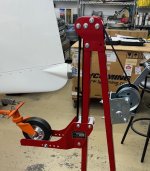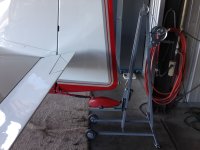scsmith
Well Known Member
Yesterday I received my Flyboys tailwheel lift. You might recall a posting a little while ago soliciting interest in putting the tail wheel lift back in production, after the original producer stopped making them, at least I think that is how the story goes. Anyway, I responded at that time that I would be interested. When I do oil changes, I have to lift the tail up on a stool to get the sump level enough to drain completely. There are other times when it is handy to have the fuselage level too. I'm just getting a little too old to keep risking my back lifting the tail up onto the stool. Also the airplane is very vulnerable with the tail on a stool, even with the wheels chocked. Anyway, a couple of weeks ago, I got an email from Flyboys saying that the lift would be ready for shipment in a few weeks and would I like to buy one. So I paid them and it arrived yesterday.

 flyboyaccessories.com
flyboyaccessories.com
I put it together at the hangar today and tried it out. It was easy to assemble, and it works exactly as advertised. If I were to find any complaint, it would be that at one step in the assembly, you have to remove an existing bolt in the supplied hand-crank-winch to change the lift strap, and of course that bolt and nut are metric. Since (as far as I know) there is not a single metric fastener in my airplane, there are no metric tools at the hangar. I had to improvise.

I think if I swiveled the tail wheel around to the normal position, the rudder would clear the lifting post.
As a product development suggestion, I would say to design a companion system that is beefier for heavier tailwheel airplanes. This one has a capacity of 150 lbs, and I am pretty sure the C-180 Skywagon tail is heavier than that to lift (ask me how I know).

Experimental Aero Tail-Lift
There are a number of good reasons you might need to lift the tailwheel of your airplane and there are precious few good ways to do the job. You could lift the tail by hand and stack a pile of junk to create a wobbly platform to put the tail on. If you're lucky, you might throw out your back in...
I put it together at the hangar today and tried it out. It was easy to assemble, and it works exactly as advertised. If I were to find any complaint, it would be that at one step in the assembly, you have to remove an existing bolt in the supplied hand-crank-winch to change the lift strap, and of course that bolt and nut are metric. Since (as far as I know) there is not a single metric fastener in my airplane, there are no metric tools at the hangar. I had to improvise.
I think if I swiveled the tail wheel around to the normal position, the rudder would clear the lifting post.
As a product development suggestion, I would say to design a companion system that is beefier for heavier tailwheel airplanes. This one has a capacity of 150 lbs, and I am pretty sure the C-180 Skywagon tail is heavier than that to lift (ask me how I know).






